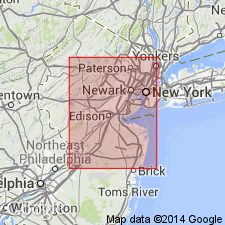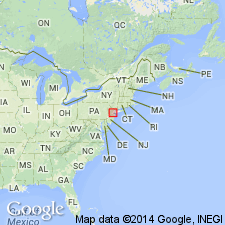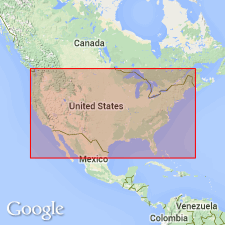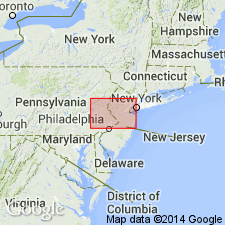
- Usage in publication:
-
- Watchung trap sheets
- Modifications:
-
- Original reference
- Dominant lithology:
-
- Lava
- AAPG geologic province:
-
- Piedmont-Blue Ridge province
- Newark basin
Summary:
Pg. 134-139; 1890, USGS Bull. 67. Watchung trap sheets. Three thick sheets of extrusive lava interbedded with the sediments of Newark system [group] in Watchung Mountains.
[GNC remark (ca. 1936, US geologic names lexicon, USGS Bull. 896, p. 2283): Being interbedded flows, the Watchung basalt is treated as part of Newark group.]
Source: US geologic names lexicon (USGS Bull. 896, p. 2283).

- Usage in publication:
-
- Watchung traps*
- Modifications:
-
- Original reference
- Dominant lithology:
-
- Lava
- AAPG geologic province:
-
- Piedmont-Blue Ridge province
Summary:
Three long concentric sheets of lava, interbedded with sedimentary strata of the Newark System in the Newark area, NJ, are named the Watchung traps and are assigned to the Newark System. The first and second Watchung traps constitute the ridges of the First and Second Watchung or Orange Mountains. The third Watchung trap constitutes a line of ridges known as Packanack Mountain, Towakhow (Hook) Mountain, Riker's Hill, and Long Hill, or Third Watchung Mountain. The traps are characterized by conformity to underlying strata, trap breccias, and columnar structure.
Source: GNU records (USGS DDS-6; Reston GNULEX).

- Usage in publication:
-
- Watchung lava flows*
- Modifications:
-
- Revised
- AAPG geologic province:
-
- Newark basin
Summary:
The Watchung lava flows of the Newark group are listed as the First, Second, and Hook Mountain flows. Extended to NY.
Source: GNU records (USGS DDS-6; Reston GNULEX).

- Usage in publication:
-
- Watchung basalt†
- Modifications:
-
- Abandoned
- AAPG geologic province:
-
- Piedmont-Blue Ridge province
- Newark basin
Summary:
The Watchung basalt of Darton (1890) is here abandoned and replaced by the Orange Mountain, Preakness, and Hook Mountain Basalts, which are equivalent to the First, Second, and Third basalts, respectively.
Source: GNU records (USGS DDS-6; Reston GNULEX).

- Usage in publication:
-
- Watchung Basalt
- Modifications:
-
- Not used
- AAPG geologic province:
-
- Piedmont-Blue Ridge province
Summary:
The Orange Mountain, Preakness, and Hook Mountain Basalts of Olsen (1980), which replace the Watchung Basalt, abandoned by Olsen, are here adopted by the USGS and assigned to the revised Brunswick Group. Age of the basalt flows is Early Jurassic.
Source: GNU records (USGS DDS-6; Reston GNULEX).
For more information, please contact Nancy Stamm, Geologic Names Committee Secretary.
Asterisk (*) indicates published by U.S. Geological Survey authors.
"No current usage" (†) implies that a name has been abandoned or has fallen into disuse. Former usage and, if known, replacement name given in parentheses ( ).
Slash (/) indicates name conflicts with nomenclatural guidelines (CSN, 1933; ACSN, 1961, 1970; NACSN, 1983, 2005, 2021). May be explained within brackets ([ ]).

